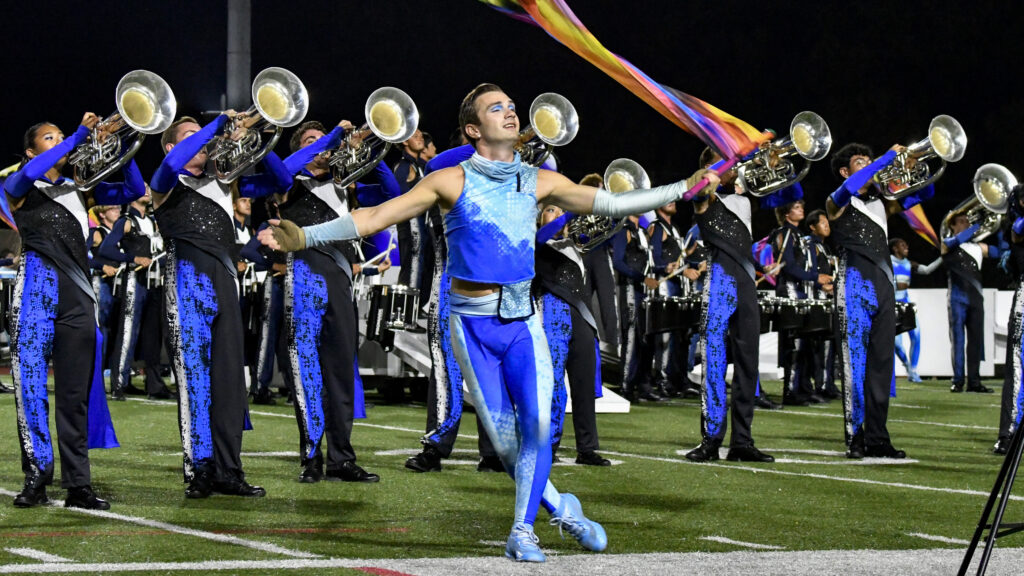The 1988 Drum Corps International World Championships headed to Arrowhead Stadium just outside of Kansas City.
Competitively, the two-point separation between first and fifth place in the Finals competition was the smallest margin in DCI history up until 2015’s spread of 1.75 points. The 12-point spread between the first and 12th-place finalist corps remains the smallest margin in DCI history.
Also unique to this season, Semifinals scores were not released until after Finals, and corps drew from a hat for Finals performance order. The adjudicators for the Finals competition were also selected in the same manner.
Madison Scouts took home the 1988 title; this after the corps took a 20-day 50th anniversary tour of Europe in late June and early July. Blue Devils, under the leadership of their first director after the retirement of founder, Jerry Seawright, switched their iconic blue uniforms to black and gray. The Devils remained undefeated until placing second in Semifinals and third in Finals, with Santa Clara Vanguard finishing in second for the fourth year in a row.

The 11th-place Bluecoats lived up to fans’ expectations with an entire show of jazz tunes. The opener was “That Old Black Magic” by Harold Arlen, who also wrote the drum corps classics “Blues in the Night” and “Over the Rainbow.” Arlen and lyricist Johnny Mercer composed the tune for the 1942 film, “Star Spangled Rhythm,” which featured a massive all-star cast.
The show started with 30 counts of drum intro as a brass formation rotated into position for a big fanfare hit, ending with a few soprano players screeching high notes before going into the melody portion of the song.
From there on out it was classic Bluecoats; swinging, brash, and with a heavy backbeat that made one want to tap along on the off beats. Although there wasn’t much of it, occasionally, the drums would sneak in with a little salsa beat.

The corps chose Paul Desmond’s “Take Five,” originally recorded in 1959 by the Dave Brubeck Quartet for the album, “Time Out,” as the second tune. It became a surprise breakaway hit and remains the biggest-selling jazz single in history. Brubeck’s visit to Turkey inspired the album, where he observed an ensemble of street musicians performing folk songs influenced by exotic Bulgarian time signatures.
The drums kicked off the piece with some cowbell before the horns came in, playing a rhythm that was decidedly not in a five-four time signature of the original. With claves playing a persistent rhythm in the not-so-subtle background, snare drummers walked up to two racks of timbales, cowbells, and ride cymbals to play an Afro-Cuban salsa rhythm.
For a Caribbean drum break, the color guard members on rifles donned alternating yellow and white ruffled sleeves over their costumes to create a fiesta look, sequentially tossing the rifles between spinning flags. After listening to this arrangement, one could be forgiven for wondering if some newcomers to “Take Five” may not have realized the piece was originally written in 5/4 time.

Bluecoats turned to “Autumn Leaves,” written in 1945 by Joseph Kosma and Jacques Prévert as the French song, “Les Feuilles Mortes (The Dead Leaves),” for its closer. The corps brought the tune back from its 1987 production. A front ensemble intro led into a solemn bugle statement of the main melody, followed by a samba whistle introducing the up-tempo segment of the tune.
This piece, more than any other, became most associated with Bluecoats’ style of jazz. An extended drum break led to nine snare drummers playing crossed-hand maneuvers with their neighboring drummer, soon joined by 11 more snare drummers from the tenor drum and cymbal line. This always elicited one of the most enthused audience reactions of the year. Ten huge silks filled up the backfield as the horns marched to the front, with the soprano players kneeling for the last few counts of the show.
This was only the second year that the corps placed among the top-12 finalists, but already, fans were learning that an enthusiastic performance from the corps required an equally enthusiastic yelling of “Bloo!” from the stands.
1988 Overview

Michael Boo was a member of the Cavaliers from 1975-1977. He wrote about the drum corps activity for more than 35 years while serving as a staff writer for various Drum Corps International projects. During his lifetime Boo wrote for numerous other publications including an honors-winning book on the history of figure skating. He also was an accomplished composer. Boo passed away in 2020 and was inducted into the DCI Hall of Fame posthumously in 2021.





